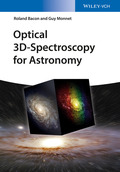Optical 3D-Spectroscopy for Astronomy

1. Auflage April 2017
XIV, 276 Seiten, Hardcover
122 Abbildungen (97 Farbabbildungen)
Praktikerbuch
Kurzbeschreibung
This must-have single source provides an up-to-date view of 3D Spectrographs widely used for astronomical observations. It treats visible, near-IR and near-UV, giving advice on the best observing strategy, instruments and how to manage the resulting data.
Jetzt kaufen
Preis: 145,00 €
Preis inkl. MwSt, zzgl. Versand
Euro-Preise für Wiley-VCH- und Ernst & Sohn-Titel sind nur für Deutschland gültig. In EU-Ländern gilt die lokale Mehrwertsteuer. Portokosten werden berechnet.
DAS Referenzwerk mit aktuellen Informationen zu 3D-Spektrographen, die bei astronomischen Beobachtungen weit verbreitet sind, beschäftigt sich mit Licht im sichtbaren Nah-Infrarot- und Nah-UV-Bereich, erläutert die besten Beobachtungsstrategien und Instrumente und zeigt, wie die erzielten Daten verwaltet werden.
Part 1: 3D Instrumentation
2 The Spectroscopic Toolbox
2.1 Basic Spectroscopic Principles
2.2 Optics & Coatings
2.3 Detectors
2.4 Interferometers
2.5 Dispersers
2.6 Mechanics & Cryogenics, Electronics
2.7 Management, Timeline & Cost
2.8 Exercises
3 Scanning Spectrographs
3.1 Scanning Long--Slit Spectrograph
3.2 Scanning Fabry--Perot Spectrograph
3.3 Scanning Fourier Transform Spectrograph
3.4 Exercises
4 Integral Field Spectrographs
4.1 Lenslet--based Integral Field Spectrograph
4.2 Fiber--based Integral Field Spectrograph
4.3 Slicer--based Integral Field Spectrograph
4.4 Exercises
5 New Trends in Integral Field Spectroscopy
5.1 Deployable Multi--object Integral Field Spectrograph
5.2 Paving the Field: parallel replicated Instruments
5.3 An Example: Autopsy of the MUSE wide--field Spectrograph
5.4 Exercises
6 Future Trends in 3D Spectroscopy
6.1 Photonics--based Spectrographs
6.2 Quest for the Grail: towards 3D Detectors
6.3 Exercises
Part 2: Using 3D Spectroscopy
7 Data Properties
7.1 Data Sampling
7.2 Noise Properties
8 Impact of Atmospheric Turbulence
8.1 Basic Principles
8.2 Seeing--limited Observations
8.3 Adaptive Optics Observations
8.4 Space--based Observations
9 Data Gathering
9.1 Planning Observations
9.2 Estimating Observing Time
9.3 Observing Strategy
10 Data Reduction
10.1 Basics
10.2 Specific Cases
11 Data Analysis
11.1 Kinematics
11.2 Spectrophotometry
11.3 Crowded Fields
11.4 Faint Point--like Sources
11.5 Faint Surface brightness Sources
11.6 Spatial Deconvolution
11.7 High Contrast Imaging
12 Conclusions
Bibliography
Annex 1: Hints to Exercises
Guy Monnet is an astrophysicist, with 50-year experience of developing astronomical instrumentation, on the ground and in space, mostly with a 3D spectroscopic flavor. Successively, he was director of the Marseilles Observatory, Lyon Observatory and the Canada France Hawaii Telescope Corporation. He then took the position of Head of Instrumentation at the European Southern Observatory (1995-2009) and the Australian Astrophysical Observatory (2010-2011). His main scientific domain is the dynamics of stars and ionized gas in galaxies.


